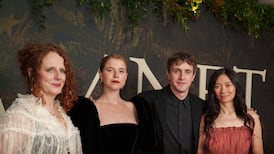Every chemistry lecture should start with an explosion. Prof Andrew Mills of the University of Swansea duly obliged by throwing light on chlorine gas, which instantly developed an explosive relationship with some hydrogen.
It was the first Irish Times/RDS Science Today demonstration lecture, staged to bring science to the widest possible audience, particularly to students.
The series got an even more spectacular send-off, with a rocket launch at the finish. It wasn't the Space Shuttle taking off from Florida, but it is amazing what an electrical spark can do with some old-fashioned rocket fuel (oxygen and hydrogen) contained in a plastic lemonade bottle. Detonation was marked by a mini-thunder clap and a flash of light, before the plastic rocket raced across the stage at the RDS concert hall.
It was, however, the flash rather than the explosion that was the focus of Prof Mills's presentation with his colleague, Dr Peter Douglas. The two are photo-chemists, and in between spectacular experiments and photochemical effects, they brought in the serious side of science: how light in combination with chemicals triggers important reactions.
Many associate energy with heat, failing to appreciate that light can be a frequent result of such reactions, sometimes exclusively so, Prof Mills explained.
The two readily drew applause from the students, most of whom are in transition year, but they decided to stop short of demonstrating how the hydrogen bomb works, preferring instead to show its mushroom cloud in a slide.
They did, however, show off the "chemiluminescent stick" developed by the US army in an attempt to out-fox the "supreme eyes" of the Viet Cong, who guided their way through the jungle using glow-worms in jars. We see such science applied nowadays in the form of emergency lighting.
Not surprisingly, the young audience was especially interested in how fluorescence can cut a dash when going to a disco, where UV light will get them noticed if their shirts are "whiter than white" with the presence of optimal brightener. The presenters also suggested that they include among their accessories synthetic rubies and chunks of calcite - and that they drink tonic water - because all these fluoresce under UV light.
The application of light to technology, notably photography, was demonstrated by Dr Douglas, who showed how it is used to make tiny wires, hundreds of times thinner than a hair, for computer micro-circuitry.
With energy shortages dominating all state agendas as never before, Prof Mills predicted light-driven chemistry could make up the shortfall. The use of light to generate electricity was proving to be very cheap, though the problem of storing electricity efficiently arose. The "silicon solar cell" may be the solution.
Introducing the lecture, Dick Ahlstrom, the Irish Times Science Editor, said while there should be a place for fun in science, the lecture series also was designed to encourage students to consider a scientific career, notably in physics and chemistry. In recent years there has been a decline in those studying the latter two subjects.
If there were insufficient science students, he said, there would as a consequence be an absence of science teachers and scientists. Young people should realise this would have a real impact in their lives. Without the scientists, there would be no Sony play-stations, and no special effects in the films of tomorrow, such as Jurassic Park III, when that came.
The demonstration of photo-chemistry will also be presented to second-level students from the mid-west region at Limerick Institute of Technology tomorrow.









